California State Guard
The California State Guard (CSG), formerly known as the California State Military Reserve, is one of three branches of the Active Militia of the California Military Department.[12] The State Guard was formed to provide California with a trained and organized military force in the event of a state security or natural disaster emergency, to augment the California National Guard or when the National Guard is deployed. Its current mission is articulated in California Military & Veteran's Code § 550:[13]
| California State Guard | |
|---|---|
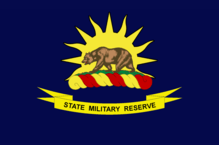 Bear flag insignia | |
| Active | 1846–present |
| Country | |
| Allegiance | |
| Type | State defense force |
| Role | Provide an adequately trained and organized State military reserve force under the exclusive control of the Governor[1][2] |
| Size | 900+ |
| Part of | California Military Department |
| Nickname(s) | CSG |
| Motto(s) | Ready to Respond |
| Engagements | Mexican–American War[3] American Civil War[4][5] |
| Website | calguard.ca.gov/casg |
| Commanders | |
| Commander-in-Chief | Governor of California Gavin Newsom |
| Commander | MG (CA) Jay Coggan[10] |
| Command Sergeant Major | CSM (CA) Daniel M. DeGeorge[11] |
| Insignia | |
| Shoulder sleeve insignia | 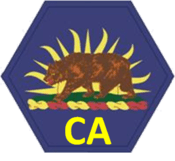 |
| Distinctive unit insignia |  |
| Beret flash |  |
"... as the Governor may deem necessary to defend and for the security of this State ..."
For the 2012–2013 fiscal year, the CASG had 1400 volunteers[14] and its expenditures were $620,000.[15]
Organization
The California State Guard (CSG) is authorized as a state defense force under the provisions of the Title 32, United States Code, Section 109(c)[16] and the California State Military Reserve Act (codified in the California Military and Veterans Code).[17] It is one of five components of the California Military Department[18] and has legal standing as part of California's Active Militia.[19]
Members and recruiting
The force consists of citizens or individuals who have begun their naturalization process, who possess a variety of skills; many members are veterans of other branches of the United States Armed Forces as well as former members of the California Army and Air National Guard. All citizens over the age of 18 who are not felons and possess a high school diploma or GED are eligible to apply for membership, although military veterans and those with special skills which materially contribute to the CSG's mission are preferred.
Members are considered uncompensated state employees,[20] although when called to Emergency State Active Duty (ESAD), they become compensated employees at the same rate as National Guard members of the same rank.[21] Reimbursement may also be provided in limited circumstances for travel, billeting and meals when directly supporting a National Guard mission.
Unlike the Civil Air Patrol or the United States Coast Guard Auxiliary, the CSG is a statutory military entity of the State with each CSG member subject to the Uniform Code of Military Justice (UCMJ) per CMVC § 560.[22]
Training and qualifications
Former members of the military are likely to have a smooth transition into the CSG. If the break in service is long (more than six years), the soldier may need an adjustment period while going through IET (see below) to come up to speed with modern Army and National Guard practices. Any MOS qualifications, ribbons, medals, badges, or awards earned in federal or state national guard service transfer directly; this includes "combat patches". Depending on the rank earned and length of time since separation, previously-held rank in those services also transfers.
CSG regulations require all soldiers to attend the Basic Orientation Course (BOC) which consists of basic military customs and courtesies and a general overview of the CSMR, and lasts a few days at most.[23] In addition to this, any soldier entering the CSG in the southern region must attend an Initial Entry Training (IET) course through the 223d Training Support Regiment, Southern Detachment. This is a five-month course where soldiers report to a student chain of command that changes every month. They are given weekly homework and accountability tasks to strengthen unit cohesion and train soldiers on how to interact with the chain of command. Every month roles are switched around and new soldiers are assigned as squad leaders while soldiers completing Echo track (final phase) graduate and are released to their gaining units. During this five-month course they report for UTA at the Training Company IEP (Initial Entry Platoon). They are taught customs and courtesies in depth and practice drill and ceremony. This is the most physical part of the training; the course is similar to federal boot camp curriculum and training without the physical component. Soldiers are required to maintain Army height and weight standards, but that is done on the soldier's own time. There is no CSG equivalent to Advanced Individual Training (AIT): This is done on the unit level once the soldier arrives from IET.
Other schools are available to soldiers who want to rise in rank. These include NCOA (Noncommissioned Officer's Academy) which has three levels of courses: BLC (Basic Leadership Course: E4-E5), ALC (Advanced Leadership Course: E5-E6), and SLC (Senior Leadership Course: E7 and above). These courses are broken into four or five live-in phases at Camp San Luis Obispo for three days each. On the officer's side is OCS (Officer Candidate School) which is an intense, year-long course meeting six times at Camp San Luis Obispo for live-in phases of four days each. In both courses, work is done on-site and during the interim.
While prior service soldiers retain any MOSq obtained previously, non-prior-service soldiers have no MOS qualification. When Army Knowledge Online (AKO) accounts were available, CSG soldiers could take courses and become MOSq in select MOS's; however there is no AKO replacement for non-veteran soldiers to obtain an MOS. Soldiers with civilian qualifications that meet or exceed Army standard for a particular MOS are used as Subject Matter Experts (SME) to train their National Guard counterparts. An example of this is the Small Arms Training Team (SATT) which is responsible for small arms training for the California National Guard.
Units
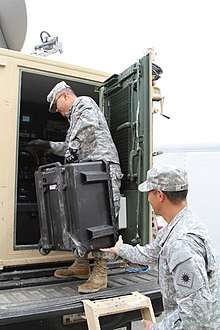
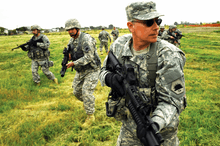
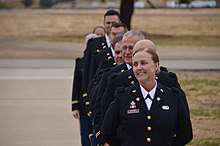
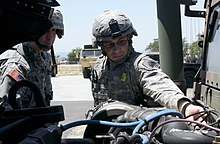
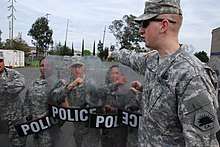
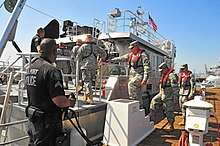
.jpg)
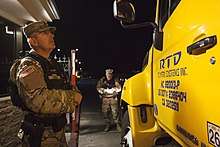
As of 1 August 2016, the California State Guard has been reorganized. Most units have now been directly embedded with and placed under the operational control of National Guard units throughout the state. The current organization is as follows:[24]
- Headquarters, California State Guard
- Headquarters and Headquarters Detachment (HHD)
- J1 (Administration and Personnel)
- J3 (Operations)
- J4 (Logistics)
- J5 (Strategic Plans)
- J6 (IT and Communications)
- J8 (Finance and Resource Management)
- J9 (Civil Support)
- Provost Marshal
- Recruiting
- Staff Judge Advocate
- Trial Defense Services
- Band
- 40th Support Command
- 79th Support Brigade
- 100th Support Command
- 224th Support Brigade
- Special Operations Detachment
- 49th Support Brigade
- 143rd MP Support Battalion
- 185th MP Support Detachment
- 579th Engineer Support Detachment
- 223rd Training Regiment
- Aviation Support Brigade
- Center for Military Heritage
- North
- South
- Chaplain Command
- Joint Task Force, Air
- 115th Support Group
- 129th Support Group
- 144th Support Group
- 146th Support Group
- 163rd Support Group
- 195th Support Group
- Installation Support Command
- Joint Forces Training Base, Los Alamitos
- Camp Roberts
- Camp San Luis Obispo
- Legal Support Command
- Maritime Command
- MARCOM Headquarters
- Maritime Coastal Command ONE
- Maritime Littoral Command TWO
- Maritime Cyber Detachment THREE
- Maritime Coastal Command FIVE
- Medical Command
- North
- South
- Youth and Community Programs
The command structure prior to August 2016 was as follows:
- Headquarters, California State Military Reserve
- Headquarters Company
- State Surgeon Office
- Chaplain's Office
- Staff Judge Advocate Section
- Provost Marshal's Office
- Regional Support Command - North
- 1st Task Force
- 2nd Task Force
- 1st Special Troops Battalion
- 2nd Special Troops Battalion
- Detachment #3, Small Arms Training Team, Camp Roberts CA
- Regional Support Command - South
- 1st Brigade (Army Support)
- 1st Battalion (Army Support)
- Alpha Company (Moreno Valley)
- Bravo Company (Azusa)
- 2nd Battalion - JFTB Los Alamitos
- Headquarters Company (HHC)
- Alpha Company (Search and Rescue)
- Bravo Company (Hazmat)
- 1st Signal Support Company (Signal/IC4U)
- 3rd Battalion (San Diego)
- 1st Battalion (Army Support)
- 2nd Brigade (Civil Support)
- 1st Battalion - JFTB Los Alamitos
- 2nd Battalion - Kearny Mesa
- 1st Brigade (Army Support)
- Installation Support Command
- ISC, Camp San Luis Obispo
- ISC, Camp Roberts
- ISC, JFTB Los Alamitos
- Military Museum Command
- Museum Support Unit
- Military History Unit
- 1st Field History Unit (North)
- 2nd Field History Unit (Central)
- 3rd Field History Unit (South)
- Troop Command
- Recruiting Task Force - North
- Recruiting Task Force - Central
- Recruiting Task Force - South
- Inactive Reserve Control Group
- Trial Defense Service Augmentation Detachment
- Training Battalion - Youth Programs
- Detachment A – CSLO
- Detachment B – Los Alamitos
- Detachment C – Oakland
- Detachment D – California Cadet Corps Support
- Headquarters, Air Support Command
- ASD – 129th RW Support Unit
- ASD – 144th FW Support Unit
- ASD – 146th AW Support Unit
- ASD – 162nd CC Support Unit
- ASD – 163rd RW Support Unit
Federal activation
Like other state defense forces, CSG members are generally not subject to federal activation. However, 10 USC 331-333 may grant powers to the federal government to call up the CSG,[25][26] because militia is defined as both organized (National Guard) and unorganized under 10 USC 311(b).[27] In addition, Article II, Section II of the United States Constitution further states:
"The President shall be commander in chief of the Army and Navy of the United States, and of the militia of the several states, when called into the actual service of the United States"[28]
Duties
The CSG accomplishes its Homeland Security Mission by providing individual soldiers, sailors, and airmen as well as rapid response teams to Defense Support of Civil Authorities (DSCA) missions in the preparation, prevention, deterrence, preemption, defense, and mitigation of natural and man-made threats to California.
Members of the CSG are required to serve a minimum of 100 hours annually. Part of that time is spent at Unit Training Assemblies (drills) which are usually eight to twelve hours on one Saturday each month. Many units require two-day drills or more depending on their mission. These drills are used for training sessions, activity coordination, and to work with their National Guard counterparts. CSG soldiers embedded with National Guard units for training purposes will drill the full weekend - or longer - with their National Guard counterparts.
Uniforms
CSG Soldiers of the Army Component wear the standard Army Service Uniform (ASU Class A and Class B) and Mess Dress for formal occasions, as well as the Army Combat Uniform (ACU), OEF (Multicam) and OCP Scorpion utility uniform. Wear-out date for the ACU is the same as the Army National Guard. CSG airmen of the Air Component wear the standard U.S. Air Force Service Dress and Mess Dress uniforms, as well as the Airman Battle Uniform (ABU) utilities. MARSCOM Sailors wear uniforms similar to USN NWU Type III, referred to as MWU (Maritime Working Uniform). All uniforms have distinctive state insignia designating them as a member of the California State Guard. This includes the buttons on the ASU, which are the same as worn by the California Highway Patrol on its dress uniforms, a unique beret flash, and a name badge indicating the wearer is a member of the "CA State Guard". Utility uniform nametapes bear the word "California" rather than "U.S. Army" or "U.S. Air Force". Unlike most SDFs, CSG personnel wear the U.S. Flag on their right shoulder (Army component wear "Flag forward"). Combat patches are worn on the right shoulder. A unique CA unit patch is worn on the left shoulder.
Awards and decorations earned from prior service in other branches of the military may be worn, so it is not unusual to see a CSG Soldier wearing "water wings" earned while on active duty in the USN, and ribbons and decorations earned in other branches. CSG also has its own unique awards and decorations. All officers and enlisted members are responsible for purchasing their uniforms and accessories. This could require an initial investment of $300 or more for utility uniforms, boots and accessories. Purchase of an ASU, rucksack, LBE, etc. adds substantially to the cost. A yearly $125 uniform allowance has been authorized for all CSG soldiers and airmen who have maintained 100% attendance in a twelve-month period.[29]
The Center for Military History has a Distinctive Unit Insignia which is worn by members. Legal Support Command wears the DUI for JAG.
Naval Militia
The California Military and Veterans Code also provides for a naval branch.[30] The California Naval Militia was founded in 1891 and grew to have many ships and sailors at statewide ports, from San Diego to Eureka. It provided officers and sailors to the U.S. Navy during the Spanish–American War and World War I.[31] The California Naval Militia was reactivated in 1976 by the Governor of California.[32][33] Unlike New York and the few other states with ship-borne active naval militia units, the California Naval Militia was, until 2017, a small unit of military lawyers and strategists who provided advice and legal expertise in the field of military and naval matters for the benefit of California's state defense force. The California Naval Militia was last mustered into the Navy during World War I.[34]
Effective 1 October 2015, California approved the process of reactivating and standing up the Naval Militia, initially taking the form of the "Maritime Support Element" per TAG policy memorandum dated 15 January 2016, as a component of the CASG (similar to the organization of the Maritime Regiment of the Texas State Guard) instead of a separate Branch like the New York and Ohio Naval Militias.
On 18 March 2017, the California State Guard established the Maritime Support Command (MARSCOM) under the command of CAPT (CA) M. Hanson, with SCPO (CA) E. Anderson as the MARSCOM Senior Enlisted Advisor, in a ceremony aboard the decommissioned WWII-era carrier USS Hornet.[35]
Emergency service
_Pangelinan%2C_deputy_surgeon_general.jpg)
In 2017, winter storms resulted in mudslides and flooding from February 1 to 23. A Major Disaster Declaration was issued on April 1.
In 2019, CSG service members were activated to assist evacuation and rescue operation during high water levels at the Russian River in Guerneville. CSG members were also instrumental in emergency management operations after the Ridgecrest earthquake in July 2019.
In March 2020, elements of the California State Guard were activated to provide emergency pre-hospital response to patients in response to the COVID-19 pandemic.[36]
Fire response
The California Service Guard has been called to Emergency State Active Duty (ESAD) to assist firefighting, support, relief, and shelter operations during wildfires.
A large-scale operation of the CSG was during Operation Fall Blaze in October/November 2007, in which over 100 citizen soldiers of the CASG were integrated with their National Guard counterparts to help firefighters fight the California wildfires.
The CSG took an active and vital role in the 2008 Operation Lightning Strike, when Governor Arnold Schwarzenegger called on over 2,000 troops from the California Army National Guard, Air National Guard, and California State Guard to help overwhelmed firefighters fight statewide wildfires.[37]
In 2017, the CSG was activated on ESAD orders against the Mendocino Complex Fire and the Carr Fire in 2017, and the Camp Fire in Butte County in 2018.
In popular culture
In the 2007 comedy movie Delta Farce, about a group of misfit reservists who think they are in Iraq when they are really in Mexico, the CSMR is alluded to when the characters played by Bill Engvall and Larry the Cable Guy say, "We're just State Military Reserves" "Yeah, SMURFS!".
See also
- Military of the United States
- National Guard
- California Wing Civil Air Patrol
- California Military Department
- California Maritime Academy—an unrelated maritime academy/university which is operated by the California State University.
- California Military Academy—an unrelated military training academy run by the California Army National Guard
References
- http://www.calguard.ca.gov/CSMR
- "Archived copy" (PDF). Archived from the original (PDF) on 2016-06-30. Retrieved 2016-05-24.CS1 maint: archived copy as title (link)
- https://web.archive.org/web/20120303135146/http://www.militarymuseum.org/History%20Mex%20War.html
- https://web.archive.org/web/20130207234151/http://www.militarymuseum.org/HistoryCW.html
- https://web.archive.org/web/20130118053317/http://www.militarymuseum.org/LosAngelesMountedRifles2.html
- https://web.archive.org/web/20130830013958/http://www.militarymuseum.org/HistoryIW.html
- https://web.archive.org/web/20130102210248/http://www.militarymuseum.org/HistorySpanAm.html
- https://web.archive.org/web/20130102210253/http://www.militarymuseum.org/HistoryWWI.html
- https://web.archive.org/web/20140806182344/http://www.militarymuseum.org/HistoryWWII.html
- "California State Guard Commanding General". Cal Guard - California Military Department. Retrieved 11 June 2020.
- "California State Guard Command Sergeant Major". Cal Guard - California Military Department. Retrieved 11 June 2020.
- California Military & Veteran's Code 120
- California Military & Veterans Code section 550
- California Department of Finance (2014), California Governor's Budget 2014-2015 Proposed Budget Detail, 8940 Military Department, Program Descriptions, 55 - State Military Reserve, retrieved 2017-03-28.
- California Department of Finance (2014), California Governor's Budget 2014-2015 Proposed Budget Detail, 8940 Military Department, 3-Year Expenditures and Positions, retrieved 2017-03-28.
- United States Code, Title 32, section 109(c)
- California Military & Veterans Code sections 550-567
- "California Military & Veterans Code section 51". Archived from the original on 2012-02-11. Retrieved 2009-10-19.
- "California Military $ Veterans Code section 120". Archived from the original on 2012-03-30. Retrieved 2010-06-27.
- "California Government Code section 810.2". Archived from the original on 2010-03-30. Retrieved 2009-08-08.
- "California Military and Veterans Code section 552-553". Archived from the original on 2012-10-24. Retrieved 2009-08-08.
- "Archived copy" (PDF). Archived from the original (PDF) on 2015-12-22. Retrieved 2015-12-19.CS1 maint: archived copy as title (link)
- 2017 CASG Commander's Conference Briefing
- Federal Activation of State Defense Forces
- United States Code, Title 10, Sections 331-333
- United States Code, Title 10, section 311(b)
- Article II, Section II of the United States Constitution
- "California Military and Veterans Code section 328". Archived from the original on 2012-03-15. Retrieved 2009-08-08.
- California Military & Veterans Code sections 280-301
- Naval Battalion of the California National Guard Archived 2011-07-20 at the Wayback Machine
- California Military Museum, California Naval Militia
- Mark J. Denger. "History of California State Naval Forces". Retrieved 27 August 2017.
- http://www.militarymuseum.org/Riddle.html
- Powers, K.J. (May 2017). "California State Military Reserve Establishes Maritime Component" (PDF). State Guard Association of the United States. Retrieved 13 November 2017.
- Siguenza, Edward (24 March 2020). "Historic COVID-19 mission for California State Guard". Defense Visual Information Distribution Service. Retrieved 30 March 2020.
- "Archived copy". Archived from the original on 2011-06-13. Retrieved 2009-02-28.CS1 maint: archived copy as title (link) CNG Operation Lightning Strike Begins
External links
- California State Military Reserve
- Office of the Adjutant General – the Executive Officer and Commander of the California National Guard and California State Military Reserve
- 32 U.S.C. § 109
- California Military & Veterans Code
- Index to Militia Units of the State of California 1850-1881